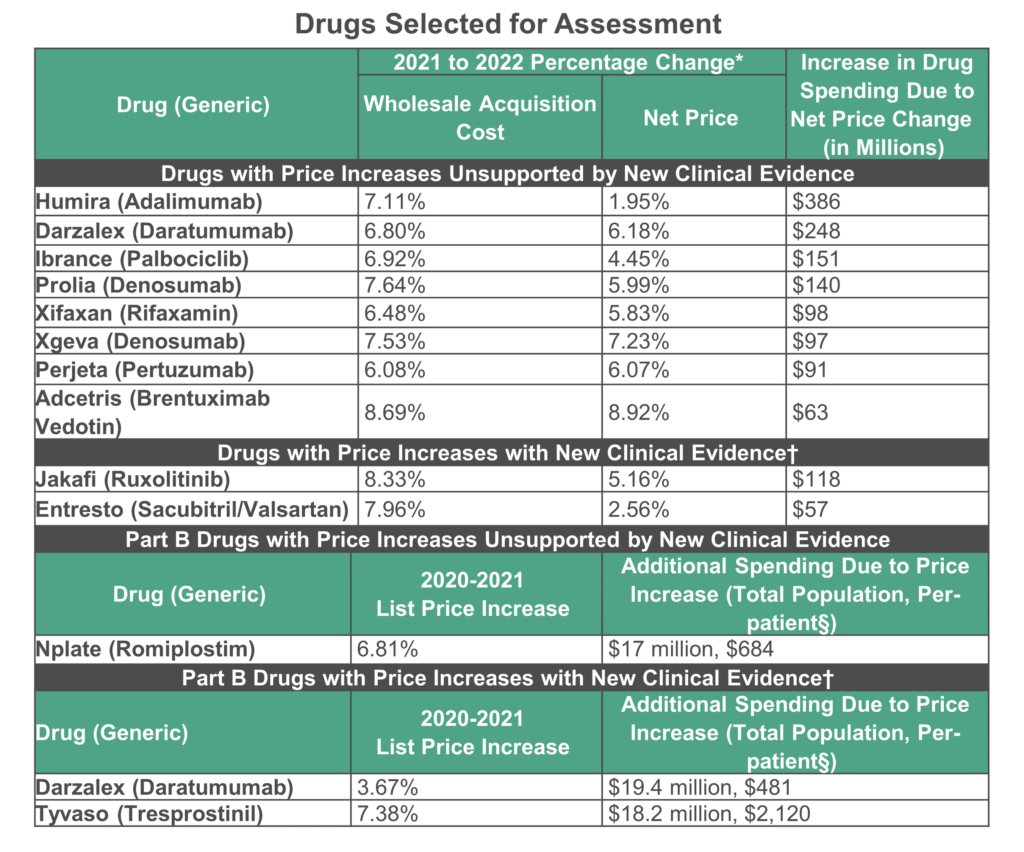— Of 10 high-expenditure drugs that had substantial 2022 net price increases, eight were not supported by new clinical evidence; these increases accounted for $1.27 billion in additional costs over one year —
— One of three Medicare Part B drugs with high list price increases in 2021 lacked adequate supporting new evidence, directly raising annual out-of-pocket expenses for Medicare patients by up to $680 per year —
BOSTON, December 11, 2023 – The Institute for Clinical and Economic Review (ICER) today published its latest report on Unsupported Price Increases (UPI) of prescription drugs in the United States. Among the top 10 drugs with net price increases in 2022 that had substantial effects on US spending, ICER determined that eight lacked adequate new evidence to support any price increase. The analysis also found that one of three Medicare Part B drugs with high list price increases in 2021 lacked adequate supporting new evidence, directly raising annual out-of-pocket expenses for Medicare patients by up to $680 per year.
Downloads: Final Report
“We continue to see list price increases above inflation for many of the most costly drugs,” said David Rind, MD, ICER’s Chief Medical Officer. “When we look further at those drugs whose net price increases led to the largest increases in US expenditures, many had no substantial new evidence to support such price increases. Additionally, list price increases can present real hardships to patients who must pay deductibles or coinsurance.”
Methodology
Consistent with our protocol announced in April 2023, ICER identified a list of prescription drugs that met each of the following criteria:
- Were among the top 250 drugs by 2022 US sales revenue;
- Had Wholesale Acquisition Cost (WAC) list price increases that exceeded the consumer price index plus 2%;
- Even after rebates and other concessions, had net price increases that placed them at the top of the list of drugs; and
- After net price increases were vetted with manufacturers, were found to be the top 10 drugs whose price increases — as opposed to volume increases — contributed to the largest increase in US spending.
This selection process produced a total of 10 prescription drugs, for which ICER then determined whether, during 2022, there was any new moderate or high-quality evidence that these treatments provide a substantial improvement in net health benefit beyond what was previously known. Following consideration of input from manufacturers and a systematic review of evidence available in published studies, ICER determined that eight of the 10 drugs lacked adequate evidence to support a claim of additional clinical benefit. These eight therapies, in order of the impact of their net price increases on US drug spending, are Humira (Adalimumab), Darzalex (Daratumumab), Ibrance (Palbociclib), Prolia (Denosumab), Xifaxan (Rifaxamin), Xgeva (Denosumab), Perjeta (Pertuzumab) and Adcetris (Brentuximab Vedotin). The complete table is found in the Key Findings section below.
As in last year’s report, an additional three therapies were identified that had the highest increases in total population-based spending by the Centers for Medicare and Medicaid Services (CMS) from 2020 to 2021 due to increases in list prices. We examined this earlier time period because of the delay in public availability of data from CMS. ICER reviews list price increases for drugs covered under Medicare Part B because we heard concerns from patient groups that list price changes in Medicare Part B often have large effects on patients even if net prices do not change significantly.
Key Findings
As noted above, ICER identified the top 10 drugs with net price increases in 2022 that had substantial effects on US spending and found that eight lacked adequate new evidence to support any price increase. These eight therapies, in order of the impact of their net price increases on US drug spending, are displayed in the following table:


Importantly, ICER’s determination that new evidence exists for treatments should not be interpreted to mean that the new evidence justifies the level of price increase; a full cost-effectiveness assessment was not conducted.
Comparison to Previous Unsupported Price Increases
In October 2019, ICER published our first UPI report, which identified seven specific drugs that experienced unsupported price increases that cost American insurers and patients an additional $4.8 billion across the two-year period of 2017 and 2018.
In January 2021, ICER published our second UPI report, this time covering only the single year of 2019, identifying another seven unsupported price increases that cost Americans an additional $1.2 billion in annual drug spend.
In November 2021, ICER published our third UPI report covering the year of 2020, and found that unsupported price increases on seven treatments, even after pharmaceutical rebates and other concessions, cost the US health system an additional $1.67 billion beyond what would have been spent if their net prices had remained flat.
In December 2022, ICER published our fourth UPI report covering the year of 2021, and found that seven out of 10 high-expenditure drugs had substantial 2021 net price increases that were not supported by new clinical evidence; these increases accounted for $805 million in additional costs over one year.
About ICER
The Institute for Clinical and Economic Review (ICER) is an independent non-profit research institute that produces reports analyzing the evidence on the effectiveness and value of drugs and other medical services. ICER’s reports include evidence-based calculations of prices for new drugs that accurately reflect the degree of improvement expected in long-term patient outcomes, while also highlighting price levels that might contribute to unaffordable short-term cost growth for the overall health care system.
